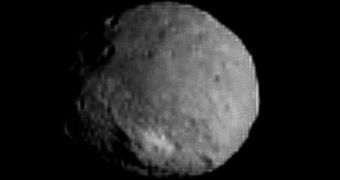Well underway to enter orbit around the largest asteroid in our solar system, the NASA Dawn space probe has just sent back a series of new images of the enormous rock. The levels of detail we now have on the object are higher than ever before.
Dawn is currently expected to start orbiting its target on July 16, and to remain in close proximity to the object for about a year, before moving on. In less than a week, NASA will put the first long-term orbiter around an asteroid.
As the spacecraft approaches its intended destination, its navigation cameras are snapping images of Vesta, which flight controllers then use to calculate small trajectory corrections, and to create new flight paths. But these images also reveal details of the asteroid itself.
The latest images were snapped from a distance of 62,000 miles (100,000 kilometers), on July 1. Their level of resolution is 5.8 miles (9.3 kilometers) per pixel, which should give you an idea of just how large the asteroid really is.
Lumps, bumps, color variations, craters and other surface features are already beginning to appear clearer in the new images, as Dawn flies ever closer to the asteroid. Experts believe that this rock is in fact a protoplanet.
That is to say, Vesta may have once had the potential to turn into a fully-fledged planet, similar to Earth or Mars in size. However, due to circumstances that astronomers want to study in detail, its formation process got halted halfway.
Now, the body features a core, a mantle and a crust, but it no longer accretes mass, which means that it cannot grow any further. Any type of internal activity has also long since stopped in its interior.
Still, that doesn't mean that experts know all there is to know about the object. In fact, they say, it could be that studying a protoplanet could reveal more of the mysteries related to how the solar system formed just millions of years after the Sun appeared.
Astronomers steer clear of classifying Vesta as a dwarf planet, especially considering that it's joined in the Inner Asteroid Belt – between the orbits of Mars and Jupiter – by the dwarf planet Ceres. The latter is also a target for Dawn.
During its stay around the asteroid, the orbiter will move between several orbits, ranging in altitude from 2,700 to 200 kilometers (1,700 to 120 miles) above Vesta's surface, Universe Today reports.
“The Dawn mission is unique in that we're going to be the first mission to rendezvous with not just one body, but two solar system bodies. These are two of the last unexplored worlds in our inner solar system,” says Dawn project manager Robert Mase, from the NASA Jet Propulsion Laboratory (JPL).

 14 DAY TRIAL //
14 DAY TRIAL //